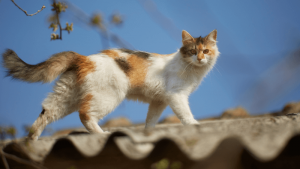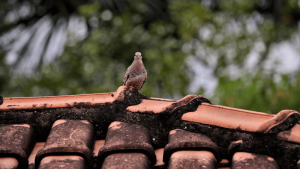Austin Animal Infestation in Multi-Family Dwelling Roofs
 You hear a rustling in the night, like little feet above your head. The dog keeps scratching at a corner of the room. Tenants complain of a foul smell that seems to come from nowhere in particular. Could it be…ghosts? No, you probably just have rats in the roof.
You hear a rustling in the night, like little feet above your head. The dog keeps scratching at a corner of the room. Tenants complain of a foul smell that seems to come from nowhere in particular. Could it be…ghosts? No, you probably just have rats in the roof.
Little animals love human habitations. Humans have pets, and garbage, and roofs with attics they seldom ever inspect. Having animals in your roof is more than just smelly and annoying, though. It can damage your home and be hazardous for everyone in the building. If you own a multi-family building that has a pest infestation, you need an inspector from the Austin roofing specialists of Kidd Roofing to take a look and find out what needs to be done to fix the problem. Call us today at (512) 671-7791 for an appointment.
What Got In, and How Did It Get There?
Even in the middle of a sprawling Texas city, there are plenty of wild animals. The usual names for these creatures are “pests” and “vermin,” but they are just the same animals that have been here the whole time. When the desert plants and rocks were moved away to make the city, they found the next best place to live: human roofs and attics.
None of the creatures in your attic are out to get you, but that doesn’t mean they’re not harmful. Most of them carry various diseases, some of them quite deadly. Many of them cause physical damage to buildings by their nesting or feeding actions. Nobody wants a houseful of rodents. Depending on where you live, you might have any or all of these little visitors in your roof:
- Rats. These rodents can gnaw through unreinforced concrete and soft steel, squeeze through holes smaller than a quarter and have the problem-solving skills of a toddler. They also carry plague in Texas, so they should be avoided.
- Bats. Bats are winged insectivores that are essential to mosquito control in croplands and deltas, but a rabies hazard near human habitations. They need cool dark nesting places and love human attics where they won’t be disturbed during the day.
- Mice. These critters are everything rats are, only smaller. They don’t have plague, which is a plus, but some species have hantavirus, which is not a plus.
- Possums. Just like rats, only bigger. Possums are less of a problem in the interior of cities, but more frequent in suburban areas. Possums are perhaps less troublesome in the roof than they are in the cellar.
- Raccoons. If there is a way in, raccoons will find it. With nimble hands and an overabundance of intelligence, raccoons will make a hole in the roof, live in the attic, nest in the chimney, and then laugh at you when you tell them to leave.
So What Can I Do?
 It isn’t as simple as just sealing up the hole the animal came in. As long as there are animals inside, you cannot fix the problem. The ones inside will continue to get out, and worse, if you seal them in, they’ll just make new holes to get out.
It isn’t as simple as just sealing up the hole the animal came in. As long as there are animals inside, you cannot fix the problem. The ones inside will continue to get out, and worse, if you seal them in, they’ll just make new holes to get out.
Animal removal takes several steps. First, the size of the infestation must be assessed, and the initial points of entry discovered. If it’s still early, there shouldn’t be too many openings to the outside.
The next phase involves sealing up the holes and removing all the animals, either by trapping or by killing. Depending on the homeowner’s preference and the type of creature, live trapping may be possible or even required. Bats in Texas are protected and may not be killed unless they are in a residential home. If you have bats in your attic, it is likely you will be asked to trap them rather than poison them.
Once the live animals are gone and as many of the dead ones as can be found are taken away, all additional potential entry points need to be eliminated. Since most of these creatures were probably scared away by the noise of the extermination, some will be back, and they won’t be deterred by one hole being blocked. A rat or raccoon can readily make a new door. Now we go to the final step.
How We Can Help
Animals like roofs because of the way roofs are constructed. Modern roofs are made in layers, and between each layer is a little space. The outermost layer, in the shingles or cladding, often has an inch or more of room for a creature to move in and start gnawing. The semi-circular “barrel” or “mission” tile roofs are havens for birds, mice, and bats because there is always a gap between the curved tiles.
Roofing experts like those at Kidd Roofing will carefully inspect your roof annually for signs of animal intrusion and nesting. It takes time for even the boldest rat or possum to get established, and our inspectors will notice signs of gnawing, chewed wires, and other damage. If we see signs of nests or droppings, we will recommend preventive measures such as:
- Sealants. Putting sealants around and beneath the shingles or other roofing materials prevents tiny creatures from crawling in and making a home. Simply blocking access means they must find another den to live in.
- Galvanized steel ridge caps and ventilation caps. Rats can, believe it or not, gnaw through soft steel if given enough time or inspiration. The extra cost of hardened steel roof caps is worth the price to prevent having animals in the attic.
- Replace gutters and trim back trees. Animals are usually after two things: shelter and water. Poorly draining gutters mean a ready source of water. Overhanging trees means that squirrels, rats, and birds can travel safely from the ground to their new nest in your attic. Keep these things in shape, and your roof is a less inviting home.
Once the creatures have gone looking for a new place to live, you should schedule regular roof inspections. Kidd Roofing will be happy to do this for you. Call us at (512) 671-7791 if you think there are uninvited guests living rent-free in your attic. We will schedule an inspection right away. Financing is available.








